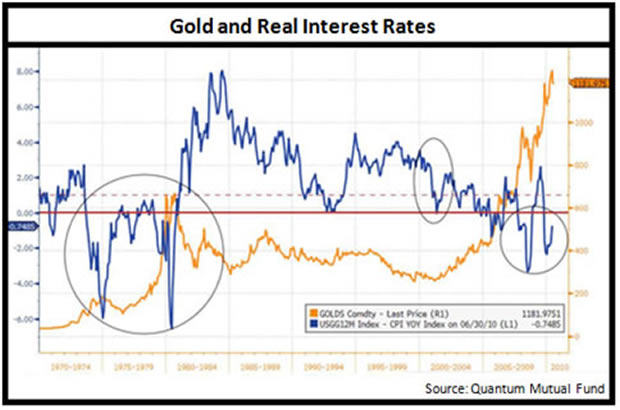What Do Rising Interest Rates Mean for the Price of Gold?
Commodities / Gold and Silver 2010 Nov 26, 2010 - 06:28 AM GMTBy: Q1_Publishing

 Over the long run, everything is driven by interest rates.
Over the long run, everything is driven by interest rates.
Stocks, bonds, gold, real estate, etc. are all heavily impacted by interest rates.
The return of the Euro debt contagion and drop in the bond markets across the world has pushed interest rates higher in the last few weeks and it has investors concerned and rightly so. Nowhere has the concern been more prominent than in gold.
A large and growing percentage of them have realized the real driver of gold prices is, has been, and will be negative real interest rates (nominal interest rates minus inflation).
Central bank policies of inducing negative real rates to incentivize borrowing (you get paid to borrow), keep money supply expanding, and devalue currencies have forced investors into real assets like gold and silver.
It has happened before and it’s happening again:

Nominal rates have stayed very low throughout the last couple of years and are so low that real interest rates must be negative.
That’s starting to change as interest rates are back on the rise. And at this point, with gold nearing new all-time highs once again, it’s a prudent move to investigate whether the recent rise in rates could slow the gold bull or completely stop it in its tracks.
The Backdrop: QE2 Backfires, Rates Rise
Rates across the board have been on the rise since the Fed announced its latest round of quantitative easing.
The yield on the 10-year U.S. Treasury bond climbed from 2.40% to a recent high of 2.90% - a relative rise of 20.8%.
The junk bond market has fared even worse. After a post credit crisis renaissance which saw record setting amounts of high-yield debt issues, the bull market has shown its first signs of weakness. The yield on CCC rated debt (official defined as: currently vulnerable and dependent upon favorable business, financial, and economic conditions to meet commitments) has increased from a 52-week low of 10.2% to 13.9% - a relative 36% increase.
Muni bonds have been hit too. The Republican takeover of the House has made a bailout of profligate spending states even more unlikely as more of them near insolvency. Merrill Lynch reports the yield investors expect on short-term muni debt has climbed from 2.4% to 3.2% - a relative increase of 33%.
In a gold bull market which has been fueled by negative real rates, conventional thinking would suggest rate increases would, at the very least, halt the rise of gold as the negative real rates get closer to turning positive.
History, however, actually says the exact opposite is true.
Rising Rates: A Symptom of Inflationary Disease
The gold bull market of the 1970s was dominated by inflation. Interest rates rose steadily to keep up with it, but real interest rates were mostly negative the entire time.
The table below shows how rising rates coincided with rising gold prices:

In 13 of the 14 years tracked both interest rates and average gold prices rose. The only exception was 1981 which came after a year when average gold prices nearly doubled.
This time around we’re seeing a very similar situation. The 10-year Treasury bond yield has increased 30% and gold prices have climbed 55% since treasuries yields bottomed out in December 2008. That move is strikingly similar to 1979 when rates increased 24.3% and gold rose 58.72%.
At the risk of saying “this time is different” though, it really is. There’s no incoming Fed chief with plans of whipping inflation now (in fact, they’re taking steps to do the exact opposite). And the political will to induce a recession that would drive housing prices to their natural levels, put an end to the stock rally, destroy the bond market, and likely bottom out near the next election, is non-existent.
So if you’re concerned about the recent rise in rates – which you should be. Rising rates are not good for stocks, bonds, or the economy.
When it comes to the gold bull market however, interest rates are likely a symptom of growing underlying inflation and, if history is any example, their rise will coincide with gold.
We continue to believe what we said in our gold stock report (follow this link to claim your complimentary copy):
Normally, gold is a poor investment. Just look at the gold bear market between 1981 and 2001. Not much money was made in gold. And from a fundamental perspective, gold is a metal with virtually no industrial uses. Gold’s not like a piece of manufacturing equipment. It’s not productive capital which you can invest in and use to increase production of something. It’s gold.
Every few decades though, the right conditions come along to make an absolute fortune in gold and gold stocks. Right now the conditions are right.
Rising interest rates are more a signal that conditions for gold are only improving.
Good investing,
Andrew Mickey
Chief Investment Strategist, Q1 Publishing
Disclosure: Author currently holds a long position in Silvercorp Metals (SVM), physical silver, and no position in any of the other companies mentioned.
Q1 Publishing is committed to providing investors with well-researched, level-headed, no-nonsense, analysis and investment advice that will allow you to secure enduring wealth and independence.
© 2010 Copyright Q1 Publishing - All Rights Reserved
Disclaimer: The above is a matter of opinion provided for general information purposes only and is not intended as investment advice. Information and analysis above are derived from sources and utilising methods believed to be reliable, but we cannot accept responsibility for any losses you may incur as a result of this analysis. Individuals should consult with their personal financial advisors.
© 2005-2022 http://www.MarketOracle.co.uk - The Market Oracle is a FREE Daily Financial Markets Analysis & Forecasting online publication.


